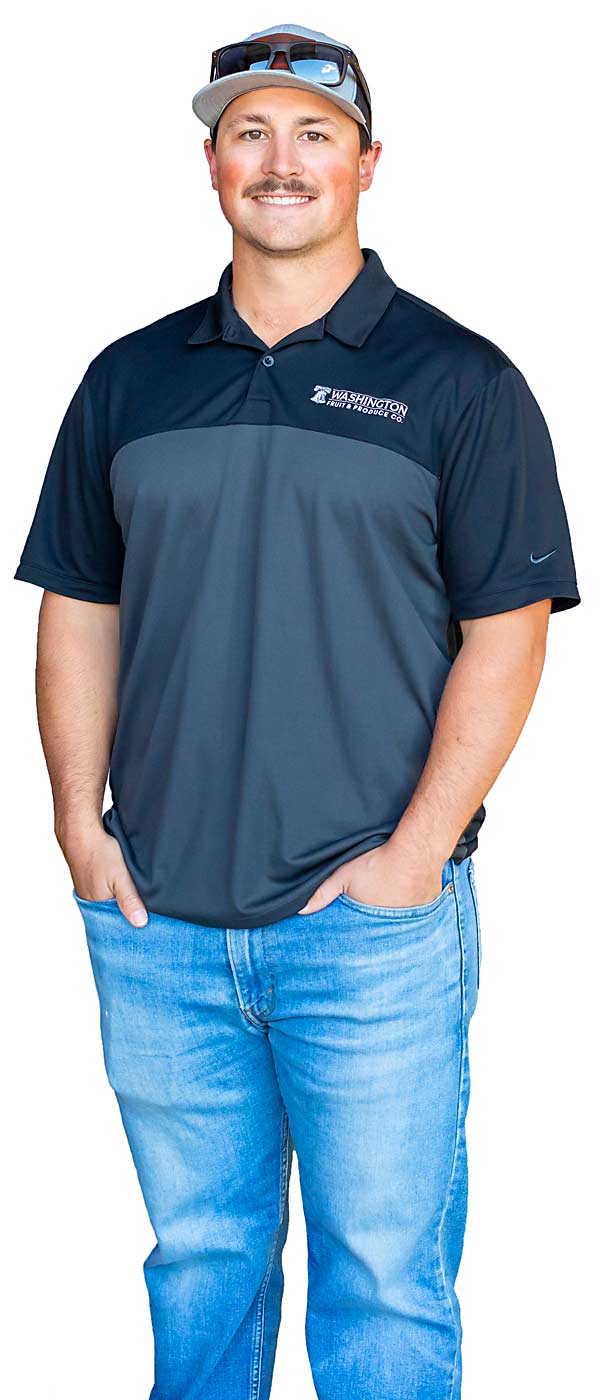family background/ Cody graduated from Washington State University with a degree in tree fruit and vegetable management and manages blocks in Quincy, Washington. He’s the son of Kelli and Randy LaRiviere and is married to Ashley LaRiviere.
age/27
grower/Yakima, Washington
crops/Apples
business/Washington Fruit and Produce Co.
How did you get your start?
When I was 14 years old, I started working in cherries out in Moxee, Washington. From there, I moved up to the cherry warehouse before college. The first college internship I had was with Washington Fruit and Produce and it was working on irrigation, spraying and eventually leading crews putting trellises in the ground.
The internship taught me just about anything and everything that makes an orchard click. Horticulture is really interesting to me because when you work with the soil, pruning and watering, you can really see the response you get from the plant.
What have you done after college?
I’ve planted an orchard the past three out of four years. My focus when preparing for these projects is to get everything set up for the foundation of that block.
Besides the orchard planning, I also manage two blocks that are mature and producing fruit, so I need to switch gears from building orchards to producing the best quality fruit with the highest yield. Those are my two priorities right now.
Is there anything new you’re working with?
I’m really excited with the new technology coming into the field — from automated irrigation valves to drone imagery and NDVI maps that show the stress of the trees and soil moisture levels.
There’s a lot of new technology that I believe will have a huge impact on the industry. One of the new things I’m working with is the automated valve systems. I used to have timers that would switch valves during cooling sets if the block used rotational cooling. But now I can switch drip sets and/or sprinkler sets.
One of the things that I need to refine is how to manage the overlap between them without potentially blowing up pipes. We’ll have to cross that bridge when we get there, but I think that’s huge. Something else that’s been around but is increasingly coming into play is using shade cloth.
What are the benefits of using it here in Central Washington?
We use a couple of different shade cloth structures; there’s a louver system and a panel system that covers an entire block on our plantings.
When you’re in an orchard that is covered, you can also see the difference in the overall tree health because the trees aren’t constantly being beaten up by the sun all day long.
With the louver, you can position it to provide protection at the later end of the day, which helps alleviate sunburn. There’s a lot of benefits to using shade cloth, although we need to continue doing research and learn ways to do the best we can with it.
The full panel system costs more than a louver system — maybe twice as much. But the install is pretty similar in general. There’s more wire and engineering that is needed for a panel system, especially when dealing with windstorms or hail. When you have hail, you end up with a considerable amount of weight, which can pop wires or break posts.
The nice thing about these systems is there’s more than one way to engineer your system and potentially split up the design, depending on what crop you want to protect.
How do new irrigation tools and data help you?
Using these new irrigation controls begins with using moisture sensors that are about 8, 12, 16 and 24 inches in the ground.
Then there’s dendrometers that are installed into the tree to help determine whether the tree is stressed — before the tree actually shows it. Those two reports help us understand whether we need to adjust the water going to those trees. Another set of data comes from devices that monitor apple sizing while they are growing.
Once an apple reaches a certain size, we can put an apple sizer on the fruit and monitor its growth to predict where you want that crop to be at harvest.
So, for Honeycrisp, we like to keep them small, peaking at 80–88. First you put the apple sizers in the block then plug your harvest date into the application, which allows you to track the growth of those apples until your harvest date, giving you a guide to follow.
For the varieties where you want to get the apples larger, then you can put the larger size into the app and also your average harvest date. Once you do that, it will help you better decide how to manage your water during the growth of the apples.
What advice do you have for other young growers?
There’s not just farming jobs in agriculture, there’s a lot of other things to do depending on your interests.
If you enjoy flying drones or mapping fruit counts by sending machines through tree rows, there’s many types of jobs for young growers. I’d look for internships for opportunities.
—TJ Mullinax







Leave A Comment